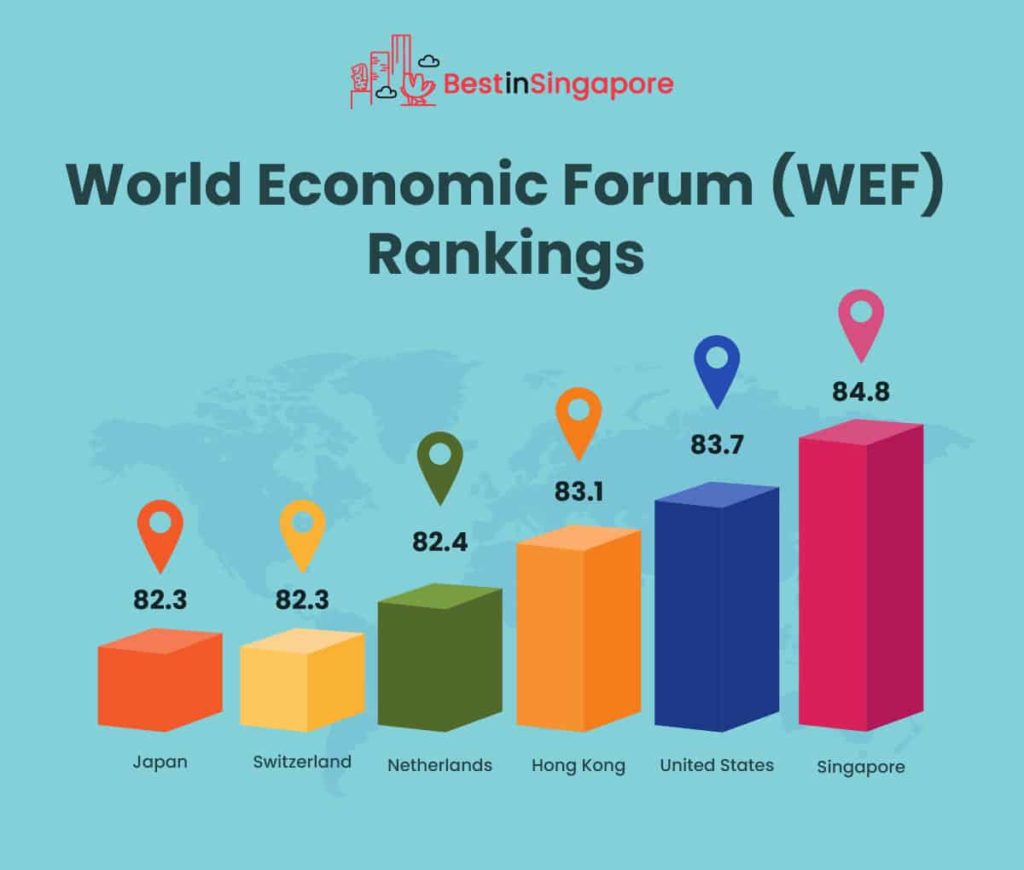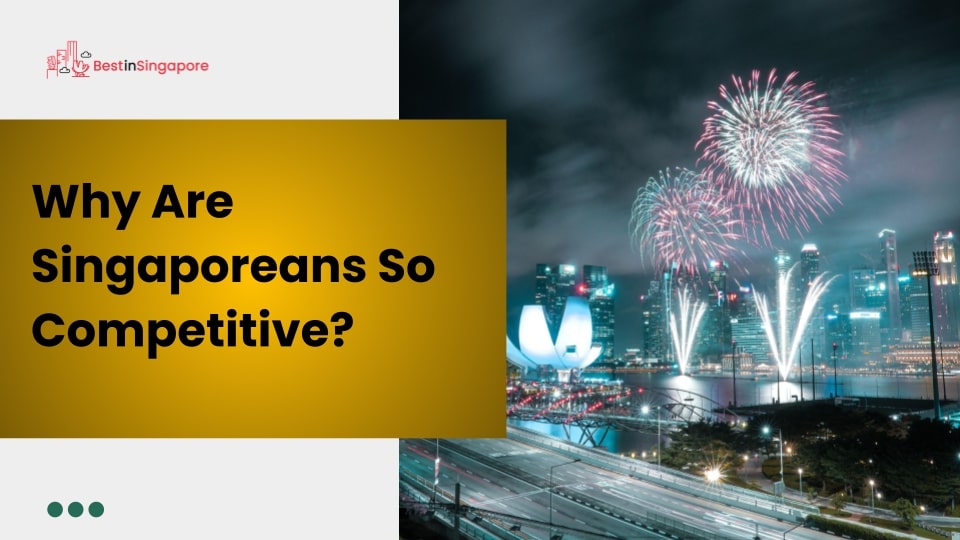Why are Singaporeans so competitive?
Singapore’s open economy and continuous improvements in the aspects of education, business legislation, employment, and public finance have made it one of the most competitive countries in the world.
This has resulted in Singapore becoming a small yet dynamic nation. In this post, we’ll be taking a closer look at the factors that make it so:
- Investor-friendly economic policies
- World-class talent
- Government and other institutions encouraging innovation
Before we get into these, let’s take a look at hard data regarding Singapore’s ranking in the world economy.
How competitive are Singaporeans?

In terms of business and government, Singapore is considered one of the most successful and globally competitive in the world. Its business and government efficiency have made Singapore a first-world country.
To further illustrate, the infographics below show the World Economic Forum (WEF) rankings of Singapore back in 2019. It reveals how, on aggregate, Singapore beat the US, Hong Kong, the Netherlands, Switzerland, and Japan on certain factors.
The WEF scores are from zero to 100, with 100 reflecting the highest productivity growth.


Singapore ranks third in the IMD global competitiveness

Singapore also ranked third in the 2022 International Institute for Management Development (IMD) World Competitiveness Ranking report. It climbed a couple of levels higher from 2021 when it was in the fifth spot.
The rankings were based on considerations such as government policies and competencies management. Other factors included infrastructure, business, and economic domains.
But there are three main factors that contribute to this current world ranking. Having an open economy is one of them, along with nurturing skills and talent that are world-class.
The third competitiveness attribute has to do with an ecosystem that uses innovation to provide structure and support for Singapore’s future generation of businesses and industries.
These attributes of Singapore’s economy show efficient use of both capital and labour. So based on this alone, it’s no wonder a lot of people think that working in Singapore is worth it.
Singapore’s Investor-Friendly Economic Policies

In spite of its small total land area, Singapore’s GDP at (nearly 397 billion US dollars in 2021) already represents an impressive 0.07% of the world economy. Even more impressive is the fact that the country’s trading capacity is thrice its GDP!
Because of its pro-business approach, foreign investors can enjoy several incentives for bringing business to the country. One of them is a competitive tax scheme, which exempts most foreign-sourced income.
Keeping corporate tax rates competitive is a great way to attract even more foreign investment. Companies that are considered Singaporean tax residents also enjoy a reduced tax concession based on the preceding year.
Aside from those, grants are also rewarded to foreign companies that can contribute training in the fields of industrial research and development and the adoption of new technologies.
Singapore corporate tax has a cap of 17%, making it easier for companies to do their accounting in Singapore, as well. The result is that multinational companies find it hard to resist Singapore’s low tariffs.
This is why over 3,000 multinational companies have set up regional headquarters here. There are also currently more than 37,400 international company headquarters in the country.
These and other investment-friendly policies directly contribute to Singapore’s sustained economic growth. In 2019 alone, it showed a robust and healthy average rate of 1.5 – 2.5% in the first quarter.
A Springboard for Businesses in the Asian Region

The nation’s strategic location and open economy make an appealing combination for other Asian businesses to regard Singapore as a global service hub.
For starters, it’s within a six-hour radius of most Southeast Asian countries, making it a highly competitive access portal to the region. In particular, Southeast Asian nations and India have made Singapore their springboard to attract investments and business.
It also helps immensely that world-class infrastructure like the Singapore Changi Airport and its main seaport welcome millions of passengers and cargo every year.
The Port of Singapore links to more than 600 international ports and is considered one of the busiest in the world.
Singapore is regarded by international investors as a business-friendly nation. An English-speaking workforce has also enticed foreigners to start or buy businesses in Singapore.
Beyond Singapore being a capitalist country, it also has a mixed economy. It’s a tiny island nation that welcomes and practices economic freedom, too.
Bilateral and multilateral agreements make up Singapore’s network of free trade agreements (FTA). Combined with its comprehensive double-tax agreement, the country’s FTA has attracted the attention of many multinational companies.
Singapore nurtures world-class talent

Singapore doesn’t have a lot of natural resources, which is why 90% of its food is imported from other countries. But what it lacks in farmland and agricultural resources, it more than makes up for with its people and innovation.
Singapore’s Competitive Education System
World-class talent has made Singaporeans the country’s most important assets. Thanks to its excellent education system, college students in Singapore can be practically assured of a successful career not long after graduating.
There are job placements at the end of their schooling. These placements are to be expected to contribute to an already world-class labour force.
Singapore workers are both multilingual and highly skilled. And combined with the latest technologies for the classroom, students in Singapore can have even more of a competitive edge.
In turn, Singapore’s labour force has come to be regarded as unparalleled all over the world.
Singapore attracts international talents
As the tax rates described in the section above show, Singapore has also managed to attract international talents and professionals from other countries.
The latter has been a significant occurrence in the face of Singapore’s dwindling population and low birth rate.
There’s been a noticeable shrinkage in the workforce even with all the abovementioned parameters in place, but the pursuit of excellence remains in its policies and priorities.
Singapore’s Innovative Ecosystem

The Singapore government invests nearly 20% of the national budget in the education sector, highlighting how the country sees it as an important tool for the economy. That’s why people know they can get the best MBAs in Singapore.
In keeping with how Singaporeans are regarded as the country’s best natural resources, being hands-on is an integral part of the university experience.
This is illustrated by Singapore’s autonomous universities. They include both academic-based and research-oriented approaches to expose graduates to a various range of industries.
However, the pursuit of knowledge and excellence in Singapore doesn’t stop when a student graduates from school. Life-long learning is behind every Singaporean’s foray into education and beyond.
Singapore’s Research Innovation and Enterprise Plan
Between 2011 and 2015, the Singapore government poured nearly S$16 billion into global research and development. The country’s Research Innovation and Enterprise Plan (RIE2020) also received S$19 billion in funding between 2016 to 2020.
RIE2020 focused on four main technology domains, including the services and digital economy, urban solutions and sustainability, advanced manufacturing and engineering, and health and biomedical sciences.
To achieve these technological goals, there are three main programmes created for them.
They include Academic Research, Manpower, and Innovation and Enterprise.
The government has also formed something called the Fortitude Budget, which aims to create more than 40,000 jobs to help boost the economy.
A knowledge-based economy is behind Singapore’s admirable innovative ecosystem. It has helped turn the country’s investments into actual solutions, services, and products.
It has also propelled Singapore to the forefront of productivity and economic growth rankings in the entire world. Even with economic uncertainties becoming evident in the past few years, Singapore wants to make sure that its workforce remains competitive.
Singapore’s Shortcomings (and What It Could Do Better)

But even with its seemingly flawless pursuit of excellence in the name of global competitiveness, Singapore can still improve in some aspects.
These challenges, including the shrinking population, can adversely affect productivity over time.
Below are just some of the more pressing ones that need to be addressed in constructive and concrete ways.
Hiring More Female Workers
In 2021, the labour participation rates were 77.2% for male Singaporeans and only 64.2% for females. The median gross monthly income and gender wage gap also favoured male workers, with a 10% wage gap in 2019.
The ratio of female to male workers in Singapore is at 0.89, making the country only 31st in the entire world for this category despite being first in workforce diversity.
Thankfully, the 2021 G20 Labour and Employment Ministerial Meeting (LEMM) in Italy witnessed how Singapore’s Minister for Manpower vowed to support more women in the workforce.
In his speech, Dr Tan See Leng mentioned the country’s commitment to providing a support system for women’s career-related and personal pursuits. He outlined four key strategies for this commitment:
- National employment facilitation programmes to help women jobseekers find better labour matches for their skills and experience;
- Flexible work arrangements to help women find a better work-life balance and more career fulfilment;
- Encouraging shared caregiver responsibilities between genders to shift societal norms away from women being the primary caregiver;
- More education and enforcement efforts to eliminate workplace discrimination and harassment and ensure a fair and safe workplace for all women.
Making Foreign Labour Employment Easier
When it comes to the ease of hiring foreign labourers, Singapore ranks only 93rd in the entire world.
As our post on how Singaporeans view foreign workers reveal, those coming from other countries who have S Pass and Employment Pass salaries are generally viewed as threats and competitors of local workers.
A Singaporean survey on foreign labour also showed that 60% of respondents felt that foreign labourers shouldn’t have the same benefits as their local counterparts.
And while there’s a streamlined process to become a foreign worker in Singapore (as outlined by the Ministry of Manpower), there are stringent requirements involved.
There’s also an existing foreign worker levy to regulate the number of foreigners in Singapore. This kind of polarised view on local versus foreign workers can be a potential threat to Singapore’s social fabric unless adequately addressed.
Better Commitment to Environmental Sustainability
In a somewhat controversial post we published, we asked why Singaporeans do not recycle.
For starters, recycling isn’t compulsory in Singapore, though it’s strongly encouraged among citizens and residents. This sort of noncommitment has earned Singapore only 66th place in terms of environmental sustainability.
And though there have been initiatives to improve Singaporeans’ recycling habits, the efforts weren’t enough to drastically improve its ranking.
Despite the country’s waste management system, the lack of cooperation from most households has jeopardised national efforts. In fact, Singapore is currently in the 199th place because of its serious lack of enforced environment-related treaties.
The WEF firmly believes that failing to address environmental sustainability and other factors will eventually result in diminished productivity.
More Public-Private Collaborations and Partnerships
With billions of Singapore dollars invested in the Research, Innovation and Enterprise Council (RIEC2020), there’s still a pressing need for private and multinational companies to partner up with public sectors on R&D matters.
Universities, hospitals, and other research institutes have already contributed to the robust research and development industry in Singapore. But private sectors can also contribute by funding or collaborating with the people who do R&D.
So while the RIEC2020 budget covers the scientists behind this initiative, private companies can also help support or fund manpower training through grants, fellowships, or expenditure sponsorship.


